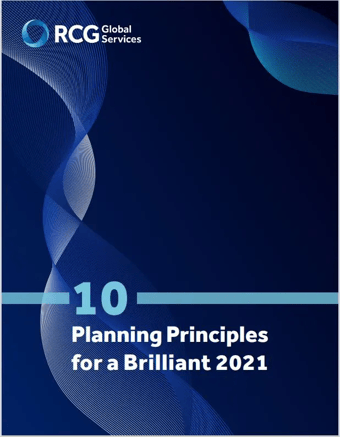10 Planning Principles for a Brilliant 2021
2020 fundamentally changed business interactions, learn how your company can plan and adapt to an ever-changing and increasingly demanding digital consumer.
Digital Fast Forward Era

The seismic behavioral shift of 2020 took days - not years - and broke all well-established behavioral norms. Companies are having to contend with and adapt to an ever-changing and increasingly demanding digital consumer. We are now in what can be called the Digital Fast Forward Era.
2020 fundamentally changed business interactions
Every company quickly adapted to a new method of commerce or shuttered the business. Senior leadership looked to the IT teams to rapidly replicate secure office network access and make programs accessible to the work-at-home workforce. Amazingly, companies were able to adapt to the new normal quickly. IT teams rose to the challenge of working long hours in concert with vendors and service providers. Employees quickly learned how to interact digitally and use conference bridges instead of fighting over conference room bookings. Companies experienced increased website traffic and demand on aging infrastructure, and responded by quickly adding vendor services to provide secure digital internal and customer-facing communications.
Customers were empathetic and willing to accept some frustrations as globally, everyone was going through the same issues. The consumer found the digital experience was a bit bumpy, digital shelves were empty, or a clumsy check out process hampered their progress. Consequently, consumers quickly responded by engaging with new and different websites based on the appearance of trustworthiness and transparency.
Focus investments on new ideas that will provide a return

As the economy starts to reopen, the pressure is returning for companies to focus on a new growth agenda. The traditional levers of undertaking minor tweaks to sales campaigns, implementing adjustments to brick-and-mortar floor plans, and looking for optimizations here or there in the business operations will no longer work. To stay competitive in the age of the digital fast forward, business models need to be rebuilt taking into account the new consumer behaviors and expectations.
The approach for planning in 2021 will need to be a bold one. What would appear to run counter-intuitive to traditional and previously proven planning is now the path forward. Companies tend to spend 92% of the yearly budget on the same goals as previous years due to a variety of reasons including politics, inertia, cognitive biases, or other areas. With little investment in innovation, companies are becoming stagnant and stale, losing ground to competition and ending up in bankruptcy or an unwilling target of mergers and acquisitions. The future is bleak for companies that stay the usual course; the reward is tremendous for those taking the bold step of re-allocating the spend – forecasted to be an average of 30 percent higher returns. (Source)
Identify key focus areas for 2021

Now is the most opportune time to shore up the foundational digital elements to enable your company to continue on the digital fast forward journey.
Can you answer the following three questions with a resounding yes?
- Are you prepared for a frantic adoption of new digital technologies
- Does your business have a strong foundation for SMAC (Social, Mobile, Analytics, and Cloud) to incorporate the latest tech trends?
- Do you have a digitally mature workforce to offer customized products and services that adapt to the continually changing realities?
In most companies, the answer will vary from “Maybe” to a resounding “No.” To move the needle to “Yes,” there are a plethora of ideas, technologies, and capabilities to leverage. With too many choices and lack of expertise in one or more areas, the journey will be difficult and companies can end up getting overwhelmed To help you think through the areas of investment with the highest potential for big returns, let’s focus on a few key foundational elements where efforts should be concentrated.
You are judged by your digital brand

Based on the digital image, trends show consumers are making purchasing decisions in increasing numbers on sites of small players and relative unknowns who offer niche branding and superior experience.
When a customer enjoys an exceptional experience with another company be it in your industry or not, your company is held to a higher standard. How often have you thought, if Amazon can make recommendations why can’t company X tell me the same thing, or if my electric company has a chat feature why doesn’t this massive company have one?
Omni-channel experiences have become the bare minimum to compete in the ever-evolving digital world. Consumers are now demanding increasing levels of transparency and ease of doing business. For example, chat features are replacing phone calls, increased self-service options of even the most complex transactions are replacing customer interactions, use of third party data such as cookies, and other data sources are building personalized recommendations based on each individualized consumer profile and replacing blanket emails/ mailers.
No longer is the digital experience only customer to business, it now encompasses all aspects of commerce from business to business, business to consumer, and consumer to consumer. With the work-at home model in full swing, the line separating personal and business has blurred. Now, previously unimaginable situations have become a reality – a typical situation would be an employee having one screen with an active video conference, and another with a grocery shopping site, while on a personal device. The ability to separate work and personal/home front matters has diminished, and companies need to learn how to sift through the mountains of digital data for the important crumb of data while providing a singular experience.
Remove technical debt to enable opportunities

The companies that succeed are the ones that are nimble and able to seize an opportunity for growth quickly. This could be implementing a new product, changing a website to account for new customer interactivity, or as simple as an implementing a chatbot.
Too often, business and technology are at odds when timelines are developed to implement the new business capabilities because of technical debt. Debt can range from quick and straightforward technology changes implemented to meet a business goal quickly instead of doing it the ‘right’ way to making a business decision to fit a given use case for a point in time without thought to the company’s ecosystem en masse.
The accumulation of the many small decisions that may appear to be inconsequential can grow into mountains that are difficult to move when the business needs to make updates or changes rapidly. Successful companies are ones that recognize the debt, continually attack the root issues, and invest in eliminating the debt over time.
The debt reduction can be accomplished in two ways. The first is through working down the debt, refactoring, fixing, or implementing changes as needed. This approach can be very costly and potentially impact business negatively due to system behavior changing unexpectedly; however, this option offers the benefit of being a lower investment in effort over time. The second way is to replace the system with new technology. This comes with a higher upfront cost and possibly more time before value realization but can quickly remove old debt. The implementation team must be held accountable not to create new debt when replacing the old.
Employee work habits and styles have changed

When the world was forced to allow remote working, 79% of the companies saw a positive or neutral change in productivity, according to a recent Willis Towers Watson survey. This effort was supported by the rapid deployment of technology to enable remote working citing examples such as the Swiss Pharmaceutical company Novartis rolling out Microsoft Teams in a week, or the hyper-local social network Nextdoor revamping their onboarding over a weekend. Encouraging too is the shift in the everyday workers’ and C-suite occupants’ perception of each other – in the same Willis Towers Watson survey, 95% of the respondents believe senior leaders have demonstrated a sincere interest in employee wellbeing, and 85% believe employees have trust and confidence in the job being done by senior executives. (Source)
With offices starting to open back up, senior and mid-level leadership must not squander the goodwill and trust earned. While working remotely, employees have been provided with increased flexibility and no commute time. The change has enabled employees to provide additional focus on work efforts but also personal time to interact via remote tools with friends and families. During remote work, the amount of e-learning, ownership of tasks, and different work habits such as work hours other than the traditional 9 to 5 have become ingrained habits. A consideration is to keep the remote work as part of the culture. Some companies such as Twitter, Square, and Facebook have made remote work for life a new standard. This does not mean the company will allow the employee to work unchecked, there must be trust with verification of the work. This can be done through outcome-focused efforts such as working down a Jira board, development of deliverable by a given date, or other measuring mechanisms.
The new employee is digital

This can range from the simplistic Robotic Process Automation (RPA) to the very complex machine learning and predictive analysis. The use of AI has been augmented by Natural Language Processing (NLP), allowing the AI to interact directly with humans.
The current workhorse of the digital workforce is RPA which is expecting an increase of 30% in customer-facing experiences (Source: Gartner Predicts 2020: RPA Renaissance Driven by Morphing Offerings and Zeal for Operational Excellence). RPA provides a variety of solutions ranging from chatbots that will respond to your customer’s first contact based on keywords from a knowledge repository to looking up the status of orders or even walking a customer through a sale. From the company facing side, RPA provides a bridge between two disparate systems without expensive interfaces or system maintenance. For example, if an employee is required to lookup data in multiple systems both internally and externally, RPA can replace that function and provide output to a spreadsheet or online form. It can be taken even a step further and perform fundamental analysis to consolidate the data and take the next step in the process. RPA can replicate what a human does with some rules on a consistent, more efficient, and less costly basis.
The more expensive digital worker is artificial intelligence, which helps employees perform complex analytical tasks such as trend analysis or predictive modeling. Using AI tools such as augmented research can review millions of data elements, determine correlation, and define models without the human biases and limitations of computation. This analysis can then be continually updated through machine learning technologies using real-world data, making an infinite number of adjustments to increase the accuracy of the model. These models did break down during the early stages of the pandemic due to the unexpected and sudden impact of behavior changes. However, they have since quickly learned the new behaviors and are trending towards more accurate results.
The digital worker is not meant to replace the employee but rather augment their work to provide a more effective and enriched working environment. The employee could be freed of mundane tasks such as data lookup, completing forms, and have the time to focus on the impactful activities such as defining a new product, preparing for a new trend, identifying a unique growth opportunity, or optimizing business processes.
Cyber security is more important

Too often, the protection of the most valuable asset in the digital age – which is data, is a lower priority due to a false sense of security. With the majority of employees working remotely, the push for more data access, data usage, and the growth of interfacing systems, the need to protect data is more critical than ever.
Securing the network when everyone was in the same building was a challenging but manageable task through the use of firewalls, active monitoring, and other security techniques. With the majority of the staff now geographically spread out and using unique, personally configured home networks, the ability to secure the network becomes even more difficult. According to Forbes (Source), there is a 300% increase in phishing emails about COVID 19 as people are concerned and desire more information on the status of the pandemic. When the emails were dissected, it was found that 71% are malware or attack emails attempting to gain access to the computer and network.
In the past, security compliance was considered a check the box, and the program continued. The culture needs to change to become security-focused where everyone plays a part. Security professionals need to become more involved in the development cycles to find potential security threats sooner and be aware of the business goals. Development and business teams need to become more security savvy and trained in what a security issue could be and the implications of development decisions. Corporations need to focus on improved planning for when a ransomware attack occurs with proper contingency plans such as separate laptops when the team’s laptops become encrypted.
10 Planning Principles for 2021

It is essential to take a step back and determine the vision of the company. Where should we focus our resources to ensure we remain a viable company with aspirations of becoming a market leader? The number of options can become overwhelming, but focusing on the following ten key areas will propel your planning efforts into meaningful action.
1. Be business outcome focused
Every program and dollar invested by the company needs to drive towards a business outcome, which could be increased revenue, decreased costs, better efficiency or support for new areas of business. Too often, companies spend money that does not provide a tangible business impact.
2. Don’t expect technology to solve everything
Adding the latest technology for technology’s sake will not provide business value and will waste valuable company resources. The question to ask, does this new technology make a difference? Will it truly impact the way the company operates? Is the current technology meeting the need within a reasonable tolerance of effort?
3. Enable the digital workforce
Look for areas where Robotic Process Automation (RPA) can alleviate employees from doing repetitive tasks. The best way to find these opportunities is to ask the employees and find out what tasks they spend the most amount of their time.
4. Enable the digital experience
Compare your digital presence not only with your direct competition but also best in class websites from other industries. What features do they have that your company can adopt and maybe even enhance?
5. Support your employees
Ensure that your employees continue to feel engaged and cared for as the remote working style becomes a standard. Efforts can include e-learning, digital experiences for employee support, and collaboration tools, to name a few.
6. Increase digital self-service
If your site doesn’t have it already, install a chat feature with a live agent. If you do have a chat feature, implement NLP and machine learning to build a knowledge repository to provide automated responses to your customers 24/7.
7. Start knocking down data silos
Review how your data is used throughout the company and determine a method to bring it all under one roof with different rooms. Data consolidation can be done through tools like RPA to bridge legacy systems, building interfaces between systems, or even exporting data into a data lake.
8. Prepare for Artificial Intelligence (AI) with small steps
AI is going to be a part of the future. What are you doing this year to prepare your company? Small things can be accomplished, such as pulling together a clean set of company data, building infrastructure to support the efforts, or starting a POC on a focused area.
9. Use meaningful metrics
My college Robert Wolverton said it best in his blog, define metrics that everyone in the company is measured by, and ensure every employee understands how their part helps the overall vision.
10. Focus on cyber security
Review your security policies with an external firm to gain a perspective on current policies. Often people will assume they have the best knowledge, but experts in this domain will be able to point out gaps you didn’t know you had and how best to close them.
Develop vision and roadmaps to get to your destination

The roadmap captures what needs to happen, when it needs to happen and who needs to do it. Too often a roadmap is forced to serve multiple purpose on multiple dimensions making it a one size fits all instead of choosing the right roadmap style for the job.
Once the roadmap has been built, it must not be placed in a drawer but rather become a living document. As Albert Einstein said, “You can’t use an old map to explore a new world.” It must be continuously refreshed as the environment changes, such as when events like the digital fast forward occurs, the company vision is updated, or as new transformative technology gets introduced. The goal of the roadmap is to serve as the North Star for your journey to change, but you must stick to the roadmap. If you take unnecessary detours to toy with every new technology or explore fads promising alternative methods to solve a business problem, you will never reach your goal. It is difficult to say no to a better way or newer technology. However, it must be done at times to keep to the timelines and meet overall goals.
Meet the challenges with accelerated innovation

But 2020 will also be remembered for the innovation and acceleration of change. Challenges arose globally - every company, worker, and consumer experienced it in one form or another. It will be those that meet these challenges head-on and build upon them that will be the successful market leaders of tomorrow.
What are you doing to make 2021 a banner year?
Contact RCG to help with roadmap and implementation of the market disruptive digital technologies.
Download a PDF version of this guide by filling out this form


